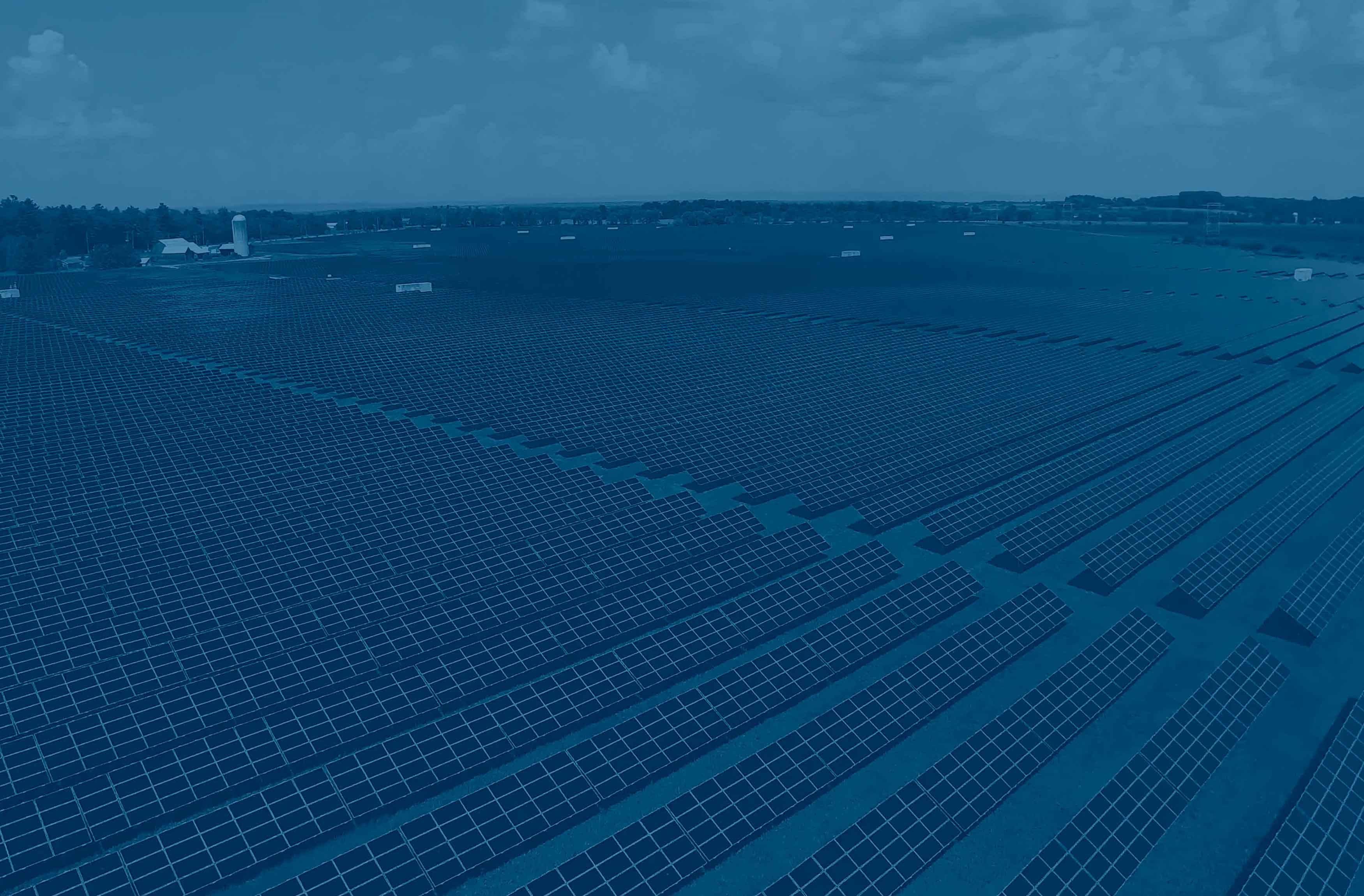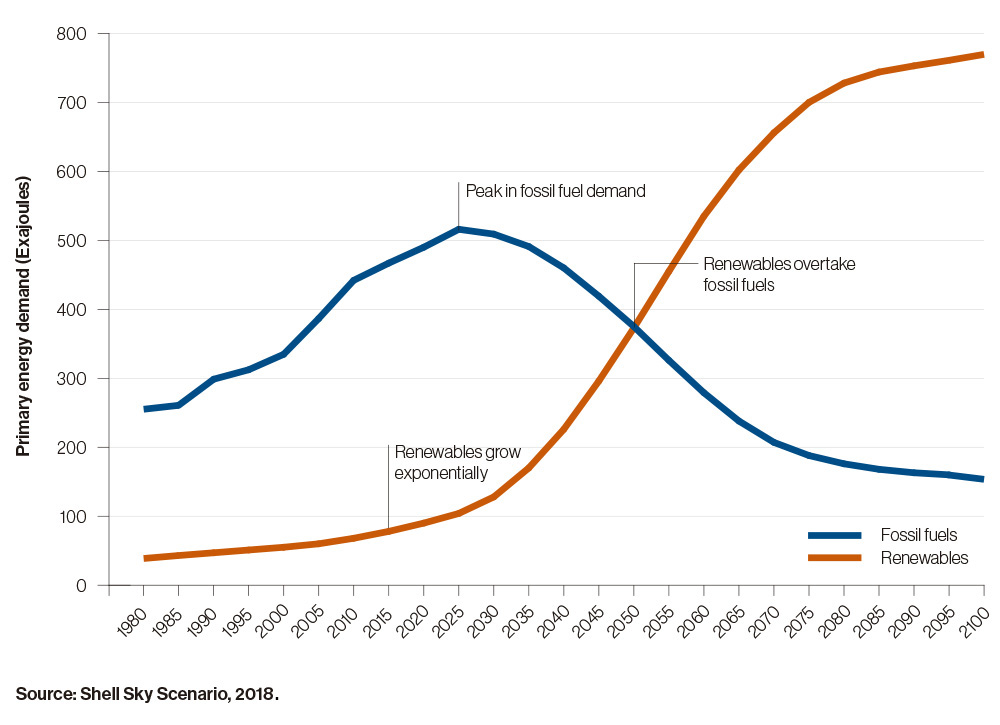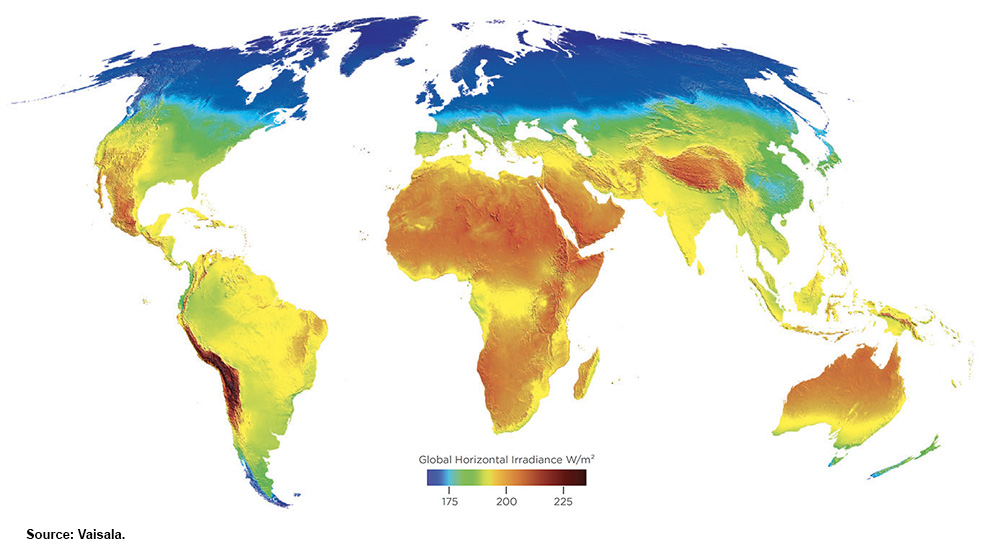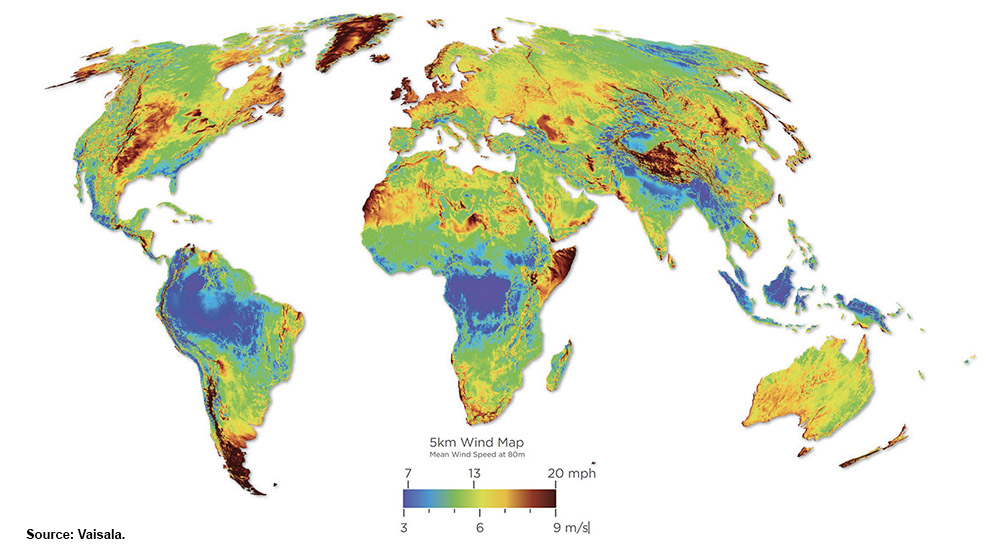Renewable sources of energy—particularly wind and solar—have grown at an unprecedented rate in the last decade and have consistently surpassed expectations. The growth of their deployment in the power sector has already outpaced that of any other energy source, including fossil fuels, which include oil, coal and natural gas. Renewables, in combination with energy efficiency, now form the leading edge of a far-reaching global energy transition.1
This ongoing transition to renewables is not just a shift from one set of fuels to another. It involves a much deeper transformation of the world’s energy systems that will have major social, economic and political implications which go well beyond the energy sector. The term ‘energy transformation’ captures these broader implications.2
The global energy transformation will have a particularly pronounced impact on geopolitics. It is one of the undercurrents of change that will help to redraw the geopolitical map of the 21st century. The new geopolitical reality that is taking shape will be fundamentally different from the conventional map of energy geopolitics that has been dominant for more than one hundred years.
Fossil fuels have been the foundation of the global energy system, economic growth and modern lifestyles. The exploitation of fossil fuels lifted global energy use fifty-fold in the last two centuries, shaping the geopolitical environment of the modern world. The geographic concentration of fossil fuels has had a significant impact on the wealth and security of nations. An energy transformation driven by renewables could bring changes just as radical in their scope and impact.
The majority of countries can hope to increase their energy independence significantly, and fewer economies will be at risk from vulnerable energy supply lines and volatile prices. Some countries that are heavily dependent on exports of oil, gas or coal will need to adapt to avoid serious economic consequences. Many developing economies will have the possibility to leapfrog fossil fuel-based systems and centralized grids. Renewables will also be a powerful vehicle of democratization because they make it possible to decentralize the energy supply, empowering citizens, local communities, and cities.
Energy transformation
Rapidly growing renewables have unquestionably started to transform the global energy landscape in an irreversible way. At the same time, considerable uncertainty still surrounds the energy transition that is taking place. As the rapid uptake in renewables shows, we live in an age of exponential change and disruption. Which technological innovations will accelerate the transformation cannot yet be foreseen. Political choices will affect the course and pace of the energy transformation, which is likely to progress at different speeds in each country and in each sector. However, three primary aspects characterize and underpin the transition: energy efficiency, the growth of renewables, and electrification.
Energy efficiency enables economic growth with lower energy inputs. In the twentieth century, the average growth rate of energy demand was 3%, about the same as the growth rate of global GDP. In recent decades, improvements in energy efficiency have broken this link. Primary energy demand is now forecast to grow at 1% a year in the period to 2040.3
Growth of renewables. Renewables have emerged as the fastest growing energy source.4 The main renewable energy sources are bioenergy, geothermal, hydropower, ocean, solar and wind. Among these, solar energy and wind power are undergoing very rapid growth, while the others are growing more gradually. Solar and wind share a characteristic that is largely unique to them: the amount of power they generate varies with the weather and the time of day. This is why they are called variable renewable energy sources.
The impact of the extraordinary growth in renewables has mostly been felt in the electricity sector. Since 2012, renewables have added more new power generation capacity than conventional sources of energy.5 Solar power added more new capacity in 2017 than did coal, gas, and nuclear plants combined.6 Wind and solar now provide 6% of electricity generation worldwide, up from 0.2% in 2000. In the aggregate, renewables account for around a quarter of global electricity generation.7
Countries such as Denmark already generate more than half their electricity from variable renewable energy sources.8 In 2017, Costa Rica’s electricity was generated entirely from renewable energy for 300 days. For several days in the past year, the power systems of Germany, Portugal and Denmark were able to run entirely on renewables.
Electrification. Electricity accounts for 19% of total final energy consumption, but its share is expected to grow as increased electrification of end-use sectors takes place.9 The deployment of heat pumps and electric vehicles, for example, permits electricity to be used for heating, cooling, and transport. Electricity has been the fastest growing segment of final energy demand, growing two-thirds faster than energy consumption as a whole since 2000. This trend is set to continue. Since 2016, the power sector has attracted more investment than the upstream oil and gas sectors that have traditionally dominated energy investment, another reflection of the ongoing electrification of the world’s economy.10
The speed of the energy transformation is uncertain. Because of the complexity of energy systems, there are as many scenarios on the future of energy as there are forecasters. Nevertheless, scenarios that model an energy future compatible with the goals of the Paris Agreement have a similar structure: a near-term peak in fossil fuel demand, a rapid uptake of renewables, and a long decline in fossil fuel demand.11 Figure 1 illustrates these dynamics. It is not a prediction, but shows a possible pathway which assumes that the world is able to achieve the goal of the Paris Agreement to limit temperature increase to ‘well below 2°C’.
Figure 1. The energy transition framework
Note: This data is taken from the Shell Sky Scenario (2018), which has the merit of forecasting to 2100 and therefore projects the nature of the energy transformation over the course of the century. Other energy transition scenarios usually have shorter time horizons. The Sustainable Development Scenario (SDS) of the International Energy Agency (IEA), for example, only looks forward to 2040. IRENA’s REmap scenario goes to 2050. Shell’s forecast share of renewables and fossil fuels is similar to that of the IEA SDS scenario for 2040 as well as the DNV GL and Equinor Renewal scenarios for 2050. The IPCC 1.5 degree median scenario and IRENA REmap scenario anticipate a substantially larger share of renewables by 2050 with an earlier peak in fossil fuel demand.
Even though nuclear energy is a low-carbon technology, the growth prospects for nuclear energy seem limited. After rapid expansion in the 1970s and 1980s, the growth of nuclear power has slowed in the last three decades. The share of nuclear in electricity generation declined from 17% in 2000 to 10% in 2017.12 Around two thirds of today’s nuclear power plants in advanced economies are more than 30 years old and will be shut down in the foreseeable future unless their lifetimes are extended.13 Some countries are building new nuclear power plants, notably China, India, Russia, and the UAE. In others, governments are planning to phase out nuclear power, as in Germany, Switzerland, Spain and South Korea.
Overall, the global energy transformation is characterized primarily by a rapid growth of renewables, and in particular solar and wind. Oil, gas and coal will be affected differently by the energy transition because they have distinct characteristics and are used in a variety of sectors.
The forces of change
Six enabling trends drive the rapid deployment of renewables.
I. Declining cost
As the costs of renewable energy technologies have fallen, the business case for renewable energy has become a major driver of change. Mature renewable energy technologies, including hydropower and geothermal, have been cost-competitive for years where they operate. However, technologies such as solar and wind have also gained a competitive edge as a result of technological advances and increased investment. The steep decline in costs of renewable energy and energy storage has surprised even the most optimistic observers. Once dismissed as too expensive to expand beyond niche markets, solar and wind can now beat conventional generation technologies on cost in many of the world’s top markets, even without subsidies.14
Since 2010, the average cost of electricity from solar PV and wind energy has fallen by 73% and 22% respectively.15 In countries as dissimilar as Chile and Saudi Arabia, India and the United States, electricity is being produced in optimal locations for around 30 US dollars per megawatt hour (MWh). Auction prices suggest that by 2020 the average cost of electricity that is generated by solar and wind sources will be at the lower end of fossil fuel electricity costs.16 The cost of lithium-ion batteries, which are used in electric vehicles, has fallen by 80% since 2010.17 As a result of these cost declines, investments in renewable technologies are increasingly driven by competitive business models and the profit motive.
Significant cost declines are expected to continue over the course of the next decade. IRENA estimates that by 2025 the global weighted average cost of electricity could fall by 26% from onshore wind, by 35% from offshore wind, by at least 37% from concentrated solar power (CSP) technologies, and by 59% from solar photovoltaics (PV).18 The cost of stationary battery storage could fall by up to 60%,19 and there is growing confidence that electric and conventional vehicles will be sold at comparable prices by the mid-2020s.20
II. Pollution and climate change
The problems caused by fossil fuels—including widespread air pollution and climate change—have led governments, businesses, investors and the public to recognize the need to decarbonize the global economy. Pollution, mainly caused by the burning of oil and coal, is making the air dangerous to breathe in many cities, from New Delhi to Beijing and Paris. The World Health Organization estimates that nine out of every ten people in the world breathe polluted air that is hazardous to health and wellbeing, and that air pollution kills 7 million people every year,21 making it the fourth largest cause of death.
Climate change poses an existential threat to humanity and the Earth’s eco-systems. Unless urgent steps are taken to decarbonize the energy sector, the world will not achieve the Paris Agreement’s goal to hold “the increase in the global average temperature to well below 2°C above pre-industrial levels and to pursue efforts to limit the temperature increase to 1.5°C above pre-industrial levels”. A recent IPCC report sets out increasingly persuasive scientific evidence of the need to limit the temperature rise to a maximum of 1.5°C to prevent long-lasting or irreversible changes, including the loss of vital ecosystems.22 At present, the world is on a course that, relative to pre-industrial levels, will increase global temperatures by at least 3°C by the end of the century.23 Another recent scientific study has warned that an abrupt domino effect may tip the planet into a ‘hothouse’ state if global temperatures rise by more than 2°C.24
Most pathways to a low-carbon economy would require the rapid deployment of renewable energy and a doubling of energy efficiency, given that the energy sector accounts for two-thirds of global emissions.25 An analysis by IRENA has shown that deployment of renewable energy combined with improved energy efficiency provides the most cost-effective way to achieve the 90% reduction in energy-related emissions that is required to meet the Paris Agreement target.26 The Sustainable Development Goals (SDGs), adopted by world leaders at the United Nations in September 2015, contain a specific goal on energy, which aims to provide universal access to modern energy services, double the rate of improvement in energy efficiency, and increase substantially the share of renewable energy in the global energy mix by 2030.
III. Renewable energy targets
Influenced by the strengthened business case of renewables and the need to decarbonize the energy sector, numerous governments have raised their ambitions and taken steps to accelerate their deployment of renewable energy. So far, 57 countries have developed plans to decarbonize their electricity sector completely, and 179 have set national or state renewable energy targets.27 Governments initially supported renewables through subsidies and mandates, but they are increasingly moving to competitive auctions that are delivering lower prices.28
Many countries are shifting to renewables because they lack oil and gas reserves and wish to be less dependent on energy imports. India, for example, is set to become ever more dependent on costly energy imports unless it changes course.29 This is one reason why it has adopted ambitious renewable energy targets.
A number of major oil-producing countries are also setting targets for increasing the proportion of renewables in their energy mix. The United Arab Emirates’ energy strategy, for example, sets an objective of 44% of renewables in its power supply and a 70% reduction in its carbon emissions by 2050. Russia auctioned 2 GW of renewables in 2017 and is planning to auction another 1 GW in 2018.
In certain countries, where central governments have been slow to establish renewable energy targets, local governments and municipalities have acted in their place. California has adopted a 60% renewable electricity target by 2030, and several cities, from Mexico City to Madrid, have announced plans to ban diesel cars.
IV. Technological innovation
Technological innovations, including higher solar photovoltaic (PV) module efficiencies and taller wind turbines, have played an important role in accelerating the deployment of renewables in the electricity sector. Patenting rates suggest that more technological innovation has taken place in the field of clean energy technologies than in traditional energy fields such as fossil fuels and nuclear.30 In the long term, next generation biofuels and renewable hydrogen generated from electrolysis may permit renewables to extend into a growing range of hard-to-electrify sectors, such as aviation, shipping and heavy industry.31
Innovations in digitalization and energy storage are also opening up new frontiers. New digital technologies, such as smart grids, the internet of things, big data, and artificial intelligence, are being applied in the energy industry, helping to raise its efficiency and accelerate the use of renewable energy within emerging smart generation and distribution systems.
New energy technologies are also being developed for energy storage, vital for variable renewables such as wind and solar. Batteries, including those in electric vehicles, are expected to become an important storage technology. Electricity can also be stored in thermal form using boilers, heat pumps or chilled water. For longer-term storage, there are other options, including compressed air energy storage or hydrogen.
V. Corporate and investor action
The actions of corporations are also driving change. Investor groups such as DivestInvest and CA100+32 are putting pressure on companies to reduce their carbon footprints. At the December 2018 climate conference in Poland, known as ‘COP24’, a group of 415 investors, representing over 32 trillion US dollars, reaffirmed their full support for the Paris Agreement and undertook to improve climate-related financial reporting. They called on governments to put a price on carbon, abolish fossil fuel subsidies, and phase out thermal coal power.33
The Norwegian sovereign wealth fund is taking steps to divest from coal, as are some private banks, including HSBC. A number of major multilateral development banks, such as the World Bank, are no longer financing coal investment. Global insurance companies such as Allianz and AXA have announced that they will phase out insurance coverage for particular coal projects.
Moreover, some of the world’s leading companies are moving to obtain all their electricity from renewable sources and encouraging their supply chains to do likewise. Both Apple and Microsoft recently announced that their facilities are completely powered by renewable energy. Many other companies, including IKEA, Tata Motors and Walmart, have committed to source 100% of their electricity consumption from renewables.34
Major companies, including fossil fuel companies, now recognize the carbon risk to their operations.35 Under growing investor pressure, for example, Shell set out a plan to curb its net carbon footprint, including the emissions by its consumers, by around 20% by 2035.36 ExxonMobil, Equinor and other oil majors support the introduction of a carbon price.
VI. Public opinion
Public opinion is also a potent force for change. In countries across the world, consumers increasingly prefer to buy products and services that have a smaller carbon footprint, and civil society movements are applying pressure on governments and companies to reduce air pollution and carbon emissions. Religious leaders are adding to the moral arguments for acting on climate change. Pope Francis, for example, has endorsed phasing out fossil fuels in the encyclical Laudato Si′.37
Public opinion is not only being expressed through words but also through direct actions. Demonstrations against air pollution have taken place in numerous cities, from Beijing to London. Approximately 15,000 Australian school children took part in a school strike to demand action by their government against climate change.38 New social movements, such as Extinction Rebellion and the Sunrise Movement, are campaigning for radical action to tackle climate change.39
Litigation is on the rise too. A court in the Hague ordered the Dutch government to reduce the Netherlands’ greenhouse gas emissions by at least 25% by 2020 compared to 1990 levels.40 Some of the world’s leading oil and gas companies are embroiled in legal disputes with cities, states and even children over the industry’s role in global warming.41
As a result of these dynamic forces of change, the global energy transformation is gathering momentum and accelerating.
Why renewables will transform geopolitics
The main story of the energy transition is the rise of renewables, particularly solar and wind, and the future decline of fossil fuels. Renewables differ in many respects from fossil fuels, and these differences will have geopolitical consequences.
First, renewable energy resources are available in one form or another in most countries, unlike fossil fuels which are concentrated in specific geographic locations. This reduces the importance of current energy choke points, such as the narrow channels on widely used sea routes that are critical to the global supply of oil.
Second, most renewables take the form of flows, whilst fossil fuels are stocks. Energy stocks can be stored, which is useful; but they can be used only once. In contrast, energy flows do not exhaust themselves and are harder to disrupt.
Third, renewable energy sources can be deployed at almost any scale and lend themselves better to decentralized forms of energy production and consumption. This adds to the democratizing effects of renewable energy.
Fourth, renewable energy sources have nearly zero marginal costs, and some of them, like solar and wind, enjoy cost reductions of nearly 20% for every doubling of capacity.42 This enhances their ability to drive change but requires regulatory solutions to ensure stability and profitability in the power sector.
The energy transformation will be one of the major elements that reshape geopolitics in the 21st century, alongside trends in demography, inequality, urbanization, technology, environmental sustainability, military capability, and domestic politics in major states.





